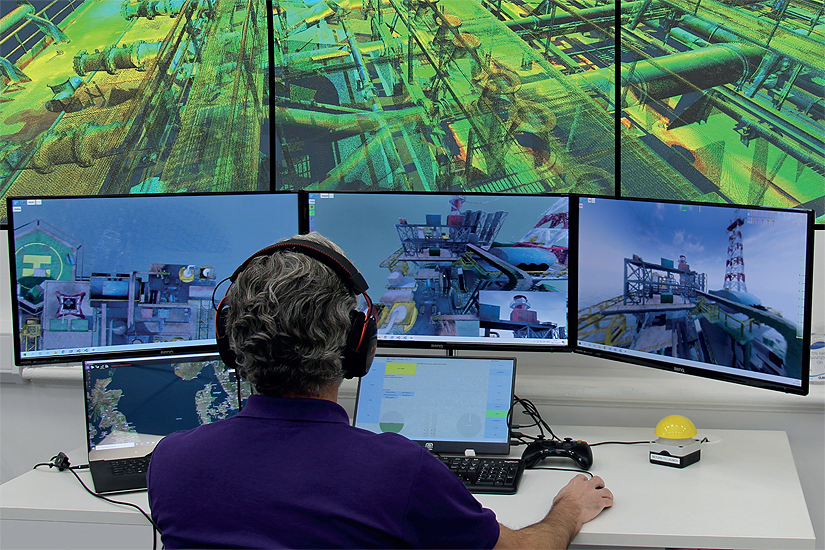
Getting ready to deploy
While our energy industry today is truly diverse, many businesses share three common goals: protecting the health and safety of workers, decarbonization and efficiency. Against a backdrop of rising demand and changes in the UK’s use, distribution and generation of energy, meeting any one of these goals is a challenge in its own right – but meeting all three necessitates an astonishing degree of innovation and agility.
In such dynamic times, it’s no wonder then that companies are harnessing technological advances to accelerate their progress.
Making the case for robotics technology
There are many examples but the one I’m going to talk about is the use of robots, in particular drones.
After almost ten years of testing and development, drones have proved their worth and are now being deployed widely across the industry in particular for remote inspection and monitoring. As a flexible, responsive inspection tool that can capture data that was previously impossible and reduce workers’ need to perform difficult, dirty and dangerous jobs, drones can help operators get a better and more timely understanding of their assets and reduce the cost of inspection of offshore oil and gas platforms, electricity networks and wind turbines.
Technology is being developed to facilitate the widest range of missions – from simple repeated missions (e.g. monitoring), to complex one-off missions in challenging environments (e.g. close-quarter flights near infrastructure assets, under oil rigs – with GPS-denial, magnetic interference and poor comms), to reactive missions, designed on-the-fly (e.g. supporting the emergency services; responding to a security or safety incident; or facilitating inspection with a remote expert in the loop).
A huge range of tools can be deployed via a drone in often hard-to-reach places including RGB cameras, Multi-Spectral Cameras, LIDAR, methane and radioactivity sensors.
Working hard to expand the potential of drones
But this is just the beginning. Until now, regulations have required pilots to be on site with their drone, keeping the drone within visual line of sight (VLOS) at all times. Scaling this model requires building and co-ordinating a large team of geographically dispersed drone pilots and managing their travel to and from mission sites. Consistent quality is challenging and expensive to achieve.
Beyond Visual Line of Sight (BVLOS) is the next phase for the drone industry. The International Civil Aviation Organization (ICAO) describes BVLOS as: “An operation in which the remote pilot…does not use visual reference to the remotely piloted aircraft in the conduct of flight.”
Operating a drone without the need or ability to keep the aircraft within view delivers greater efficiency, productivity, safety and economic value. Imagine a future where highly automated drones can be flown at short notice from a central control potentially hundreds of miles away, boosting responsiveness, dramatically cutting skills development training and minimizing the number of visits to sites overall.
UK Government, specifically the Department for Business, Energy and Industrial Strategy (BEIS), the Department for Transport and the Civil Aviation Authority, is focused on unlocking this, in the national interest.
BEIS has tasked the Civil Aviation Authority with exploring how a routine, safe means of flying drones Beyond Visual Line of Sight (BVLOS) can be achieved, including in congested, urban environments and industrial sites. In response, the CAA created the Regulatory Sandbox in April 2019 to facilitate innovation and exploration in aviation in line with CAA core principles of safety, security and consumer protection. It is already bearing fruit. In April this year, the CAA announced that is has authorized the UK’s first trials of a concept for routine BVLOS.
BEIS is also funding innovation via the Future Flight Challenge – a four year, £125m Industrial Strategy Challenge Fund (ISCF) programme, administered by UK Research and Innovation. Sellafield Ltd is playing a key role in a consortium that won a share of £30 million (Phase 2 of the Challenge) to develop and test a remotely operated drone system. The advanced system will enable remote inspection and monitoring of nuclear sites and has a range of other applications including on oil and gas installations, construction sites, road, rail and telecoms infrastructure and in providing live support to emergency services.
As a publicly funded organization itself Sellafield Ltd will not receive any of the challenge fund but the Sellafield site offers a unique testbed for the use of this technology on nuclear licensed sites and already has its own team of highly skilled and experienced drone pilots.
A safety-first approach to meeting energy demand
If we can get the technology and the protective regulations right, remote inspection and monitoring of industrial and urban areas by BVLOS drones, can play an important role in evolving how our energy production and distribution infrastructure is built and managed – reducing risk, improving health and safety, as well as unlocking huge efficiencies.
It’s a hugely exciting time to be involved with this technology, and while further tech, government and industry collaboration is needed to turn potential into reality, the recent and steady progress made by the CAA and its partners suggests that drones will be commercially deployable sooner rather than later.
By enabling organizations to access Beyond Visual Line of Sight aerial intelligence, we can help meet the UK’s growing and changing energy demands, whilst keeping workers out of harm’s way.
SEES.AI
John McKenna is CEO of sees.ai, a UK-based Beyond Visual Line of Sight (BVLOS) pioneer, focused on developing the leading Enterprise BVLOS Command & Control Solution for drone service providers. sees.ai is the only entity selected into both the CAA Regulatory Sandbox and the UK Government Drone Pathfinder backed by the Department for Transport, the Department for Business Energy & Industrial Strategy and the CAA. sees.ai was founded in 2017 by four Co-Founders ex. Arup, Apple, CERN, McLaren and hedge funds – winners of one Formula One World Championship and two America’s Cups.
For further information please visit: www.sees.ai/about-us